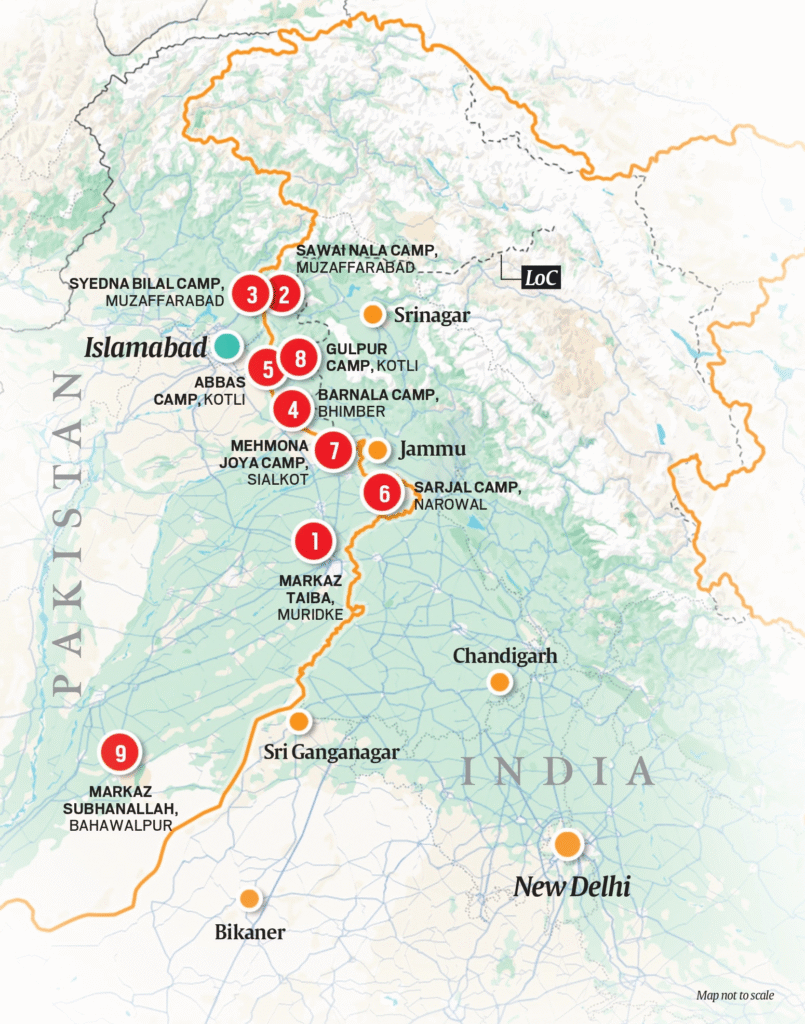Discover how China discreetly supported Pakistan during India’s Operation Sindoor on May 7, 2025. From military tech like J-10CE jets to satellite surveillance and diplomatic cover, China’s role was pivotal yet subtle. Learn why India’s BrahMos missiles outsmarted Chinese defenses, reshaping South Asia geopolitics. Packed with insights on terrorism, military strategy, and global alliances, this blog is your go-to for understanding the 2025 India-Pakistan conflict.
Introduction
On May 7, 2025, India launched Operation Sindoor, a game-changing military operation targeting terrorist camps in Pakistan and Pakistan-occupied Kashmir (PoK). Triggered by the tragic Pahalgam attack that killed 26 civilians, this 25-minute strike showcased India’s military prowess. But behind the scenes, China played a stealthy role, arming Pakistan with advanced weaponry, satellite tech, and diplomatic support. This blog dives into China’s covert involvement, India’s strategic triumph, and the geopolitical fallout that’s got Millennials and Gen Z buzzing. Ready for a deep dive into South Asia’s power play? Let’s roll!
The Spark of Operation Sindoor
The Pahalgam Tragedy
On April 22, 2025, Pahalgam, Jammu and Kashmir, was rocked by a terrorist attack that claimed 26 lives, including 25 Indians and one Nepali. Orchestrated by The Resistance Front (TRF), a proxy of Lashkar-e-Taiba (LeT), the attack fueled public outrage and set the stage for India’s retaliation [1]. For Gen Z and Millennials, this wasn’t just news—it was a call for justice in a world where terrorism hits close to home.
Operation Sindoor: A Surgical Strike
Operation Sindoor was India’s answer: a tri-service military operation involving the Army, Navy, and Air Force. On May 7, 2025, India targeted nine terrorist facilities linked to Jaish-e-Mohammed, Lashkar-e-Taiba, and Hizbul Mujahideen in Pakistan and PoK. Using indigenous weapons like BrahMos missiles, India executed precision strikes without crossing borders, wrapping up in just 25 minutes [2]. This surgical strike vibe? Total Millennial and Gen Z energy—fast, fierce, and impactful.
Why “Sindoor”?
The name Sindoor—vermilion powder symbolizing marriage in Hindu culture—was a tribute to the Pahalgam victims, especially widows left behind. In Hindu tradition, removing sindoor marks widowhood, making this a deeply emotional choice [3]. For Gen Z, it’s like a viral hashtag with heart; for Millennials, it’s a nod to cultural roots that hit hard.

Section 2: China’s Covert Playbook in Operation Sindoor
China’s role was like a plot twist in a geopolitical thriller. While publicly neutral, Beijing backed Pakistan with military hardware, tech support, and diplomatic moves. Here’s how it went down.
Subsection 2.1: Arming Pakistan’s Arsenal
China is Pakistan’s biggest arms supplier, providing over 81% of its imported weapons from 2020-2024 [4]. Leading up to Operation Sindoor, China delivered $20 billion in military equipment, including:
- Fighter Jets: J-10CE (25 units) and JF-17 Block III, built to rival India’s Rafale jets.
- Drones: Wing Loong II and CH-4 Rainbow for reconnaissance and strikes.
- Air Defense Systems: HQ-9P and LY-80 (9 batteries, $599 million) to shield key targets.
- Missiles: 240 PL-15E air-to-air missiles for air combat dominance.
- AWACS: ZDK-03 Karakoram Eagle (4 units, $278 million) for battlefield surveillance.
Table 1: China’s Military Support to Pakistan
| Category | Equipment | Details |
|---|---|---|
| Fighter Jets | J-10CE, JF-17 Block III | J-10C inducted 2022, JF-17 with AESA radar |
| Drones | Wing Loong II, CH-4 | Used for reconnaissance and strikes |
| Air Defense | HQ-9P, LY-80 | 9 LY-80 batteries, HQ-9 for urban defense |
| Missiles | PL-15E air-to-air | 240 units, boosts air combat |
| AWACS | ZDK-03 Karakoram Eagle | 4 units, enhances surveillance |
Pakistan leaned on these systems during Operation Sindoor, but India’s tech outmaneuvered them, exposing Chinese weapons as less than invincible [5].

Subsection 2.2: Tech and Intelligence Boost
China didn’t stop at weapons. It brought cutting-edge tech to the table:
- Satellite Surveillance: China tweaked its satellites, like PRSS-1 and PakSat-MM1, to give Pakistan real-time battlefield intelligence over India [5]. This was like giving Pakistan a live Google Maps of Indian military moves.
- Radar Optimization: Chinese experts helped Pakistan reorganize HQ-9P and LY-80 systems to detect Indian aircraft and missiles [5].
- Communication Tech: A banned Huawei satellite phone tied to China’s Beidou system was found in Pahalgam, hinting at deeper tech integration [5].
But India’s electronic warfare game was next-level, jamming Chinese defenses and rendering Pakistan’s tech edge useless [6]. For Gen Z tech nerds, this is pure cyberwar flex; for Millennials, it’s a reminder of India’s rise as a tech powerhouse.

Subsection 2.3: Diplomatic Shadow Moves
China played the diplomacy card like a pro:
- UN Security Council: China teamed up with Turkey and Bangladesh to block TRF and LeT mentions in UNSC counter-terrorism talks, shielding Pakistan [5].
- Disinformation Blitz: Chinese bloggers and state-linked accounts pushed fake news, hyping Indian losses and boosting Pakistan’s narrative [5]. Think TikTok-style propaganda, but for geopolitics.
- Public Facade: China’s Foreign Ministry called India’s operation “regrettable” and urged restraint, keeping its all-weather ally card hidden [2].
This mix of covert support and public neutrality shows China balancing its Pakistan alliance with India trade goals—classic geopolitical chess [5].
Quote: “China’s support keeps India on edge, but it’s strategic, not reckless.” — Srikanth Kondapalli, China expert [5].
Section 3: The Big Picture
China’s Support: Epic Fail?
China’s big bet on Pakistan didn’t pay off. India’s Air Force jammed Chinese-made HQ-9P and LY-80 systems in just 23 minutes, letting BrahMos missiles hit their marks [6]. US expert Colonel John Spencer summed it up: “Chinese air defenses were no match for India’s BrahMos” [6]. This flop hurt China’s rep as a military tech leader, a blow Gen Z and Millennials can relate to in a world obsessed with brand cred.
Table 2: Chinese Systems vs. Indian Countermeasures
| System | Purpose | Outcome |
|---|---|---|
| HQ-9P, LY-80 | Air defense | Jammed by Indian Air Force, ineffective |
| J-10CE, JF-17 | Air combat | Outmatched by Indian Rafales |
| Wing Loong II | Reconnaissance, strikes | Neutralized by Indian defenses |
| PL-15E Missiles | Air-to-air combat | Intercepted by Indian systems |
India’s Tech Victory
India stole the show with indigenous tech. BrahMos missiles, electronic warfare grids, and ISRO’s 10 satellites gave India unmatched battlefield awareness [6]. Pakistan’s counterattacks, using Chinese PL-15 missiles and Turkish drones, fizzled out against India’s defenses [5]. For Gen Z, this is India flexing its STEM vibes; for Millennials, it’s a proud moment of self-reliance.
Geopolitical Waves
China’s support highlights its goal to check India’s rise in South Asia. But its low-key stance, as Shashi Tharoor noted, shows India’s market matters in a “Trumpian world of high tariffs” [5]. India won global props from Israel, Russia, and France, though some X posts claim only Israel and the Afghan Taliban backed India [X Post: Pak_AfgAffairs]. Operation Sindoor screamed: India won’t back down, even against China’s shadow moves.
Conclusion
Operation Sindoor wasn’t just a military win—it was a geopolitical flex that exposed China’s quiet bid to prop up Pakistan. From J-10CE jets to satellite tech, China tried to tilt the scales, but India’s BrahMos and tech smarts stole the show. For Millennials and Gen Z, this is a saga of power, tech, and resilience in a chaotic world. South Asia’s future? It’s all about navigating terrorism, alliances, and global stakes. Want to weigh in? Hit up X and share your hot takes on this 2025 showdown!
References
[1] Al Jazeera, “Operation Sindoor: What’s the significance of India’s Pakistan targets?,” 2025. [Online]. Available: https://www.aljazeera.com/news/2025/5/7/operation-sindoor-whats-the-significance-of-indias-pakistan-targets
[2] The Hindu, “Operation Sindoor 2025 | Complete coverage,” 2025. [Online]. Available: https://www.thehindu.com/news/national/operation-sindoor-complete-coverage-india-pakistan-tensions-2025/article69560035.ece
[3] The New York Times, “The Symbolism Behind India’s ‘Operation Sindoor’,” 2025. [Online]. Available: https://www.nytimes.com/2025/05/07/world/asia/india-operation-sindoor-name.html
[4] The Economic Times, “India’s Operation Sindoor gambit exposes Pakistan’s made-in-China shield,” 2025. [Online]. Available: https://economictimes.indiatimes.com/news/defence/indias-operation-sindoor-gambit-exposes-pakistans-made-in-china-shield/articleshow/121112993.cms?from=mdr
[5] Rediff.com, “Operation Sindoor: How China Supported Pakistan’s Attacks,” 2025. [Online]. Available: https://www.rediff.com/news/column/operation-sindoor-how-china-supported-pakistans-attacks/20250512.htm
[6] India Today, “Operation Sindoor: Chinese air defence system weaker than BrahMos, says US warfare expert,” 2025. [Online]. Available: https://www.indiatoday.in/india/story/us-army-warfare-expert-operation-sindoor-india-military-superior-pakistan-china-air-defence-2725651-2025-05-16









